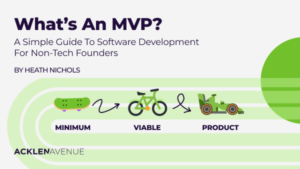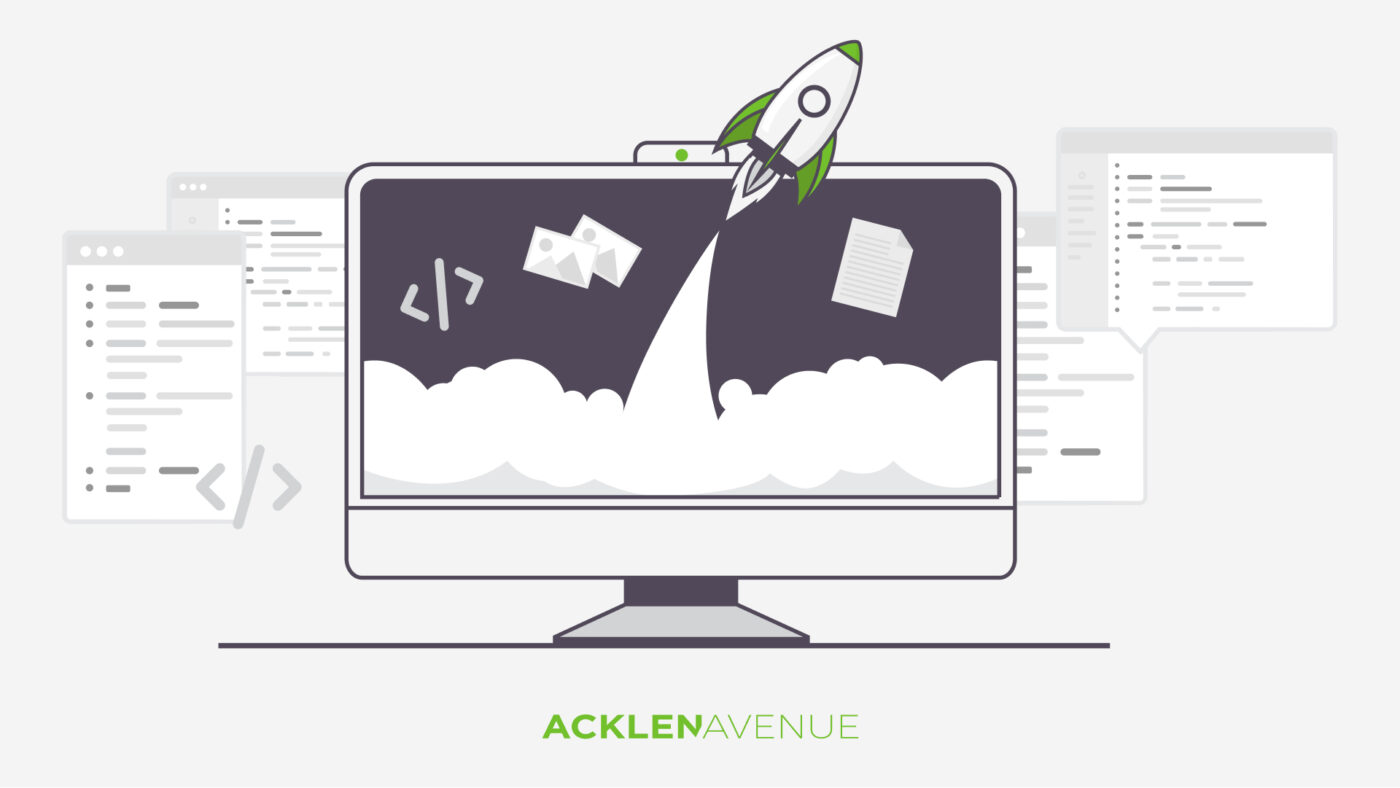
June 2, 2025
What’s an MVP? A simple guide to software development for non-tech founders.
June 23, 2022

Share:
The climb to success for any software company starts with one mission: prove your idea. The best way to validate the concept for your product is to get an MVP to the market as quickly as feasible and gain traction with paying customers. Once the market responds positively, your next goal is to prove your product by creating a focused roadmap to expand your customer base and ensure that your solution will be able to scale to meet new demands.
But how do you transition from your startup prototype to this more robust solution?
Here are 5 steps to take your initial solution to the next level:
Remember that your company is at this stage because your idea has attracted customers and started to generate revenue. These customers have found some level of value in your product and are the best ones to inform you on how to make it better.
Responding to customer feedback sounds obvious, but many companies rush into building out their next-generation product assuming they know what their market wants due to their previous success. This can cause many sophomore releases to miss the mark and result in missing an opportunity to strike while the iron is hot. Using techniques such as KANO Analysis, you can start to drill into the actual needs of your users and the features that would excite them the most.
We all know that users will often tell you one thing, then act another way. This makes it critical to verify features with actual usage statistics. If you have not added functionality to capture how your users actually interact with your product by this point, now is a great time to add it. Now you can use data to confirm or disprove any ideas you have about how features are actually used.
This type of data can also be compared to certain demographics about your users to glean essential insights. For instance, you might see that a certain report is primarily only used by customers with a certain critical mass of data. You can then start contemplating why the information in that report resonates with that specific audience more and try to capitalize on it.

If you have user and buyer personas defined, that knowledge can be used to refine those profiles to help the entire organization think more like your target market. Personas are a great addition to use with activities such as Story Mapping and Product Backlog Refinement to help the simplest and more valuable solution to your user’s problem.
One downside to all the great feedback from your market is that now you need to sort through it to find out what will have the biggest return on investment. You will most likely still be constrained by expenses, so making smart decisions around which features to spend your time and money on is crucial.
It will be nearly impossible to please every customer, and data will play a large part in helping focus your Product Roadmap. Your organization will have to make some hard decisions about what to pursue and what to delay. The previously mentioned usage statistics and user personas are integral for informed prioritization. Practices such as Weighted Shortest Job First and Cost of Delay can help determine what proposed features will have the biggest bang for your buck and take some of the emotion out of your decision making.

For more information on the Qualitative Cost of Delay, check out Blackswam Farming.
In the end, the ultimate proof is in delivering to your customers and getting their reaction. Everything else beforehand is just theory until a user actually starts using the product as intended. This makes small, quick product iterations a key part to minimizing your risk and maximizing value and learning. Don’t let perfect be the enemy of good enough. Use your personas to zero in on your users’ goals, and then use techniques such as Visual Story Slicing to refine your features to the simplest thing that will work to get them there.
Startup companies will typically utilize quick and dirty prototypes to validate their ideas in the market. It allows you to get some essential learning and possible income early without a more significant investment. This is a very feasible approach when you are relying on personal or early angel investment which makes burn rate a very real and immediate constraint.
The downside is that once you get to your next growth stage, your solution may not be robust enough to easily handle your next set of product features. As you grow your market, your current solution may not be able to scale to meet your increased user base or performance demands. Early product decisions that were made for short term business gains will start to jeopardize long term product health and become technical debt.

Depending on your business goals and financial situation, you may be faced with the decision to either re-write the solution or try to refactor what you have. A less robust solution can start to show its flaws with a high number of defects, new development frequently breaking existing features, and your time to develop a new feature growing longer and longer. Unfortunately, the effort to address all of these issues with a complete re-write can cause your rate of new feature releases to grind to a halt, which can potentially prevent you from capitalizing on current opportunities in the market.
This may be a good time to take stock of the strengths and weaknesses of the current product solution to determine how best to invest your time and money back into it. Using data from static code analysis, performance/load testing, defect heat maps, and longer than usual development times can help identify the areas of your software that are the biggest potential risks. Depending on what this data shows you, you may not need to start from scratch. You might be able to address a few key weaknesses and keep moving forward with product releases without performing a complete re-write.
Since you will be making some investments in your solution to make it more scalable, you want to ensure your team has experience in this level of software development. The developers that helped get your prototype to market quickly may not be the same ones to help you build a more robust software platform. It may be time to start investing in employees that have specialized knowledge and experience in the technologies and approaches you need to adopt for your future product releases.
Smaller startups tend to have their delivery teams wear multiple hats in their early days. Developers may also perform quality assurance testing along with business stakeholders. Company leaders may act as product managers and business analysts while also performing user acceptance testing.
Along with possibly needing a more robust technical solution, your product would also benefit from a scalable software development process with the right people in the right roles. Hiring employees with the specific skills to take on these activities can result in more consistent results.
Another way to help your delivery teams prepare for the next onslaught of feature requests is to provide them an environment that streamlines delivery and promotes quality. Implementing continuous integration and continuous delivery tools and processes can make releasing software a non-event for your teams and allow you to quickly iterate on your Product Roadmap. You can also add test automation to ensure new changes don’t break existing functionality.
After proving your idea and your product, the next typical growth stage of your company is to prove your market. At this point an organization may start investing more in sales and marketing to better pursue and expand in your target market. The customer base will become more diverse and you may even decide to change the direction of your targeting.
This will be when the flexibility and scalability of the solution will be tested. Will you be able to quickly iterate to meet the needs of your newly emerging market? Will you be able to handle larger customers and their increased amounts of users and data? If your solution is not as robust as needed, you will struggle to keep up with the market. If you did not proactively address the weaknesses of your solution in the last growth phase, your hand may be forced to address them here.

For more information on the common growth stages of a product company, check out this overview of “The Climb” by Zuora’s Chief Executive Officer Tien Tzuo.
Since an expanded sales and marketing team likely means a torrent of new product ideas, your product management team will need to be skilled at quickly sorting through these requests. Their ability to ruthlessly prioritize will allow the organization to identify the most valuable items and quickly iterate on them to maximize value and learning.
Lastly, with an expanding market and product roadmap, you may need to also expand your delivery capacity. This may mean adding employees to your engineering department or outsourcing to an external development partner. Investing internally usually sounds like the most appealing option to keep the knowledge in house, but later when you reach more of a plateau with your product roadmap you may now be a little top heavy in your engineering department which would be taking up funds that might be better spent elsewhere in upcoming growth stages.
No matter how your software company starts, they will eventually pass through the growth stages mentioned above and understanding them and how your organization may need to adapt in each one can give you a significant head start.
Hear how Acklen Avenue helped a Fintech startup take their initial software release to the next level to prepare for capturing their largest market segment ever here.